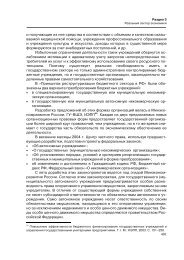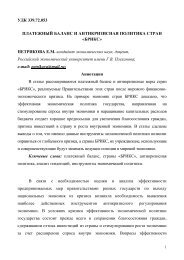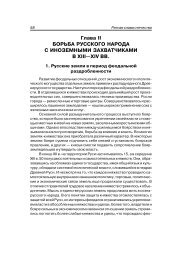Ensuring Strategic Stability in the Past and Present:
Ensuring Strategic Stability in the Past and Present:
Ensuring Strategic Stability in the Past and Present:
You also want an ePaper? Increase the reach of your titles
YUMPU automatically turns print PDFs into web optimized ePapers that Google loves.
<strong>in</strong>vok<strong>in</strong>g <strong>the</strong> prospective emergence of new nuclear states—most prom<strong>in</strong>ently, Iran <strong>and</strong> NorthKorea. Although such states would have relatively small arsenals of nuclear missiles, <strong>the</strong>ir military-political<strong>and</strong> military-strategic behaviors would be difficult to predict, compared to <strong>the</strong> behaviorof <strong>the</strong> oldest members of <strong>the</strong> nuclear club—<strong>the</strong> Russian Federation, <strong>the</strong> U.S., Ch<strong>in</strong>a, France<strong>and</strong> Great Brita<strong>in</strong>—as well as that of <strong>the</strong> club’s most recent members, such as India <strong>and</strong> Pakistan.The author would like to note that <strong>the</strong> problem of ensur<strong>in</strong>g strategic stability <strong>in</strong> contemporaryconditions must be solved <strong>in</strong> part by develop<strong>in</strong>g programs <strong>and</strong> concrete measures that are asymmetric<strong>in</strong> nature. These problems must be exam<strong>in</strong>ed <strong>in</strong> <strong>the</strong> context of <strong>the</strong> new system of geopoliticalcoord<strong>in</strong>ates that has essentially emerged before our eyes over <strong>the</strong> past 10 to 12 years.<strong>Strategic</strong> stability can be ensured with greater reliability if <strong>the</strong> process is thought of with<strong>in</strong> <strong>the</strong>same paradigm, rely<strong>in</strong>g on <strong>the</strong> logic of th<strong>in</strong>k<strong>in</strong>g that is common <strong>in</strong> contemporary scientific culture,<strong>and</strong> st<strong>and</strong><strong>in</strong>g firm on <strong>the</strong> soil of modern scientific knowledge, refus<strong>in</strong>g to yield to admonitionsby charlatans <strong>and</strong> adventurists who, as a rule, pursue <strong>the</strong>ir own selfish goals.We should watch out for possible breakthroughs <strong>in</strong> <strong>the</strong> development of different technologies,means of destruction, <strong>and</strong> weapon systems that can underm<strong>in</strong>e <strong>the</strong> balance one way or ano<strong>the</strong>r,creat<strong>in</strong>g circumstances under which <strong>the</strong> opponent may become able to surprise us <strong>in</strong> <strong>the</strong> militarytechnical<strong>and</strong> operational-strategic doma<strong>in</strong>s that arise <strong>in</strong> crisis situations. This applies not onlyto military technologies, but also to technologies that <strong>in</strong>itially appear to be completely civilian <strong>in</strong>nature.The scientific approach to <strong>the</strong> issue (<strong>the</strong> author refers here to both <strong>the</strong> natural <strong>and</strong> <strong>the</strong> social sciences)doesn’t always boil down to questions of common sense. With <strong>the</strong> help of science, one cansometimes come to conclusions (<strong>and</strong> this applies to <strong>the</strong> problem of strategic stability too) thatmay run contrary to <strong>the</strong> everyday perceptions of a person who is not <strong>in</strong>terested <strong>in</strong> science, contraryto his underst<strong>and</strong><strong>in</strong>g of what appears on <strong>the</strong> surface to be rational from <strong>the</strong> po<strong>in</strong>t of view ofcommon sense.There are certa<strong>in</strong> cycles <strong>in</strong> <strong>the</strong> development of both missile defense <strong>and</strong> strategic offensive weapons.These technical systems, which play very important roles <strong>in</strong> life-<strong>and</strong>-death issues faced bymodern civilization, as well as <strong>in</strong> ensur<strong>in</strong>g <strong>the</strong> national security of exist<strong>in</strong>g states, develop <strong>in</strong>clearly non-l<strong>in</strong>ear patterns.Politicians who must deal with <strong>the</strong> issue of strategic stability do not need advanced educations <strong>in</strong><strong>the</strong> natural sciences or eng<strong>in</strong>eer<strong>in</strong>g, but <strong>the</strong>y do need to know <strong>the</strong> overall scientific logic of creat<strong>in</strong>g,operat<strong>in</strong>g <strong>and</strong> develop<strong>in</strong>g complex social <strong>and</strong> human-mach<strong>in</strong>e systems if <strong>the</strong>y are to underst<strong>and</strong><strong>the</strong> patterns of technical evolution that def<strong>in</strong>e, to a large extent, how strategic stability isensured. The state leadership must be able to rely on a sufficiently robust national community oftechnocrats when solv<strong>in</strong>g problems related to this issue.8<strong>Ensur<strong>in</strong>g</strong> <strong>Strategic</strong> <strong>Stability</strong> <strong>in</strong> <strong>the</strong> <strong>Past</strong> <strong>and</strong> <strong>Present</strong>: Theoretical <strong>and</strong> Applied Questions
















